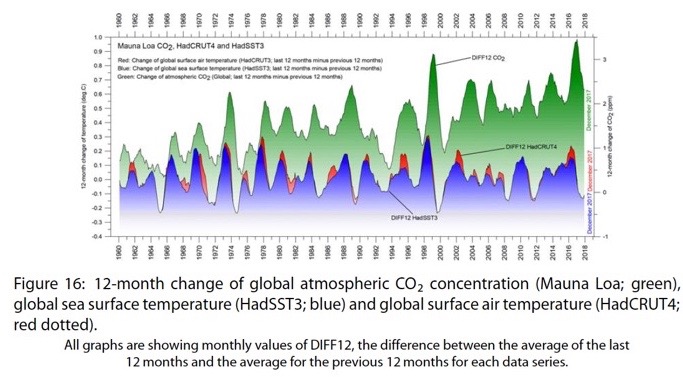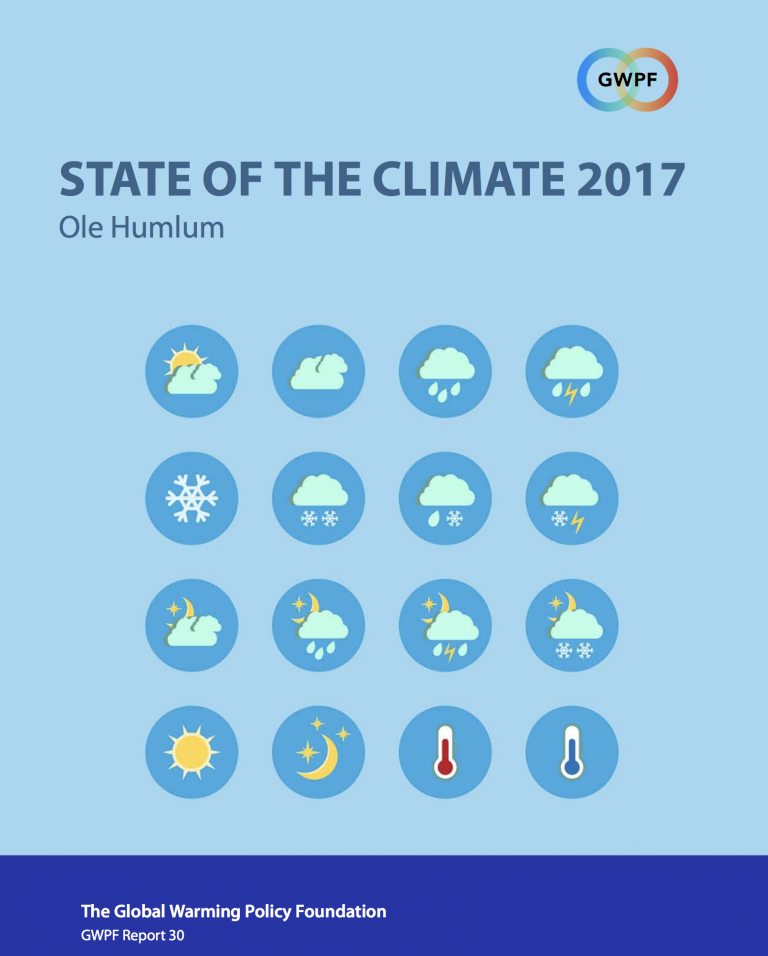Par Prof. Dr. Paul Berth
Un nouveau rapport de la GWPF (Global Warming Policy Foundation), daté du 27 mars 2018, vient de sortir : State of the Climate 2017. Il est écrit par Ole Humlum, Professeur Emérite de l’université d’Oslo et spécialisé en géomorphologie glaciaire. Ce rapport montre clairement que le réchauffement global observé ces quelques dernières années est simplement dû au phénomène naturel El Nino, plutôt qu’à l’effet de l’homme.
Dans ce rapport, Humlum présente aussi la relation entre l’accroissement annuel de la concentration de CO2 atmosphérique (Diff12 CO2), et l’accroissement annuel de la température globale de la troposphère (Diff12 HadCRUT4) et des océans (Diff12 HadSST3), et cela entre 1960 et 2018. Nous voyons clairement sur ces courbes (présentées ci-dessous) un décalage de 11-12 mois : les pics de température, précèdent les pics de CO2. Ceci est probablement une très belle illustration de la loi de Henry : lorsque l’on chauffe de l’eau les gaz comme le CO2 s’en échappent, et lorsqu’on la refroidit ils s’y dissolvent. La température des océans influence donc fortement la concentration en CO2 de l’atmosphère. N’oublions pas que 70% de la surface de la planète sont des océans! Pour plus d’infos, voir également la publication de Humlum de 2013 dans Global and Planetary Change 100:51–69 : The phase relation between atmospheric carbon dioxide and global temperature.


CURRENT LONG-TERM NEGATIVE AVERAGE ANNUAL ENERGY BALANCE OF THE EARTH LEADS TO THE NEW LITTLE ICE AGE
by
Habibullo ABDUSSAMATOV1 Pulkovo observatory of the RAS, Saint Petersburg, Russia
The average annual decreasing rate of the total solar irradiance (TSI) is increasing from the 22-nd to the 23-rd and 24-th cycles, because the Sun since the 1990 is in the phase decline of quasi-bicentennial variation. The portion of the solar energy absorbed by the Earth is decreasing. Decrease in the portion of TSI absorbed by the Earth since 1990 remains uncompensated by the Earth’s radiation into space at the previous high level over a time interval determined by the thermal inertia of the Ocean. A long-term negative deviation of the Earth’s average annual energy balance from the equilibrium state is dictating corresponding variations in it’s the energy state. As a result, the Earth will have a negative average annual energy balance also in the future. This will lead to the beginning of the decreasing in the Earth’s temperature and of the epoch of the Little Ice Age after the maximum phase of the 24-th solar cycle approximately since the end of 2014. The influence of the consecutive chain of the secondary feedback effects (the increase in the Bond albedo and the decrease in the concentration of greenhouse gases in the atmosphere due to cooling) will lead to an additional reduction of the absorbed solar energy and reduce the greenhouse effect. The start of the TSI’s Grand Minimum is anticipated in the solar cycle 27±1 in 2043±11 and the beginning of the phase of deep cooling of the 19th Little Ice Age for the past 7,500 years around 2060±11.